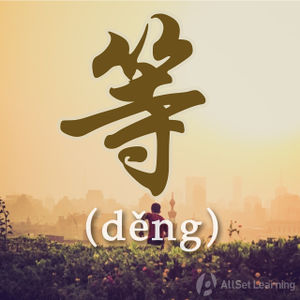Difference between revisions of "Non-exhaustive lists with "dengdeng""
| Line 32: | Line 32: | ||
=== Books === | === Books === | ||
| + | * [[Chinese Grammar - Broken down into 100 items - Basic and Intermediate Levels (汉语语法百项讲练 - 初中级)]] (pp. 304) [http://www.amazon.cn/gp/product/B004WA6JSQ/ref%3das_li_ss_tl?ie=UTF8&tag=allset-23&linkCode=as2&camp=536&creative=3132&creativeASIN=B004WA6JSQ →buy] | ||
[[Category:A2 grammar points]] | [[Category:A2 grammar points]] | ||
Revision as of 03:59, 16 February 2013
-
Level
-
Similar to
-
Used for
-
Keywords
等等 (děng děng), or simply 等, has the same meaning as “and so on” or “etc.” in English. Both are placed after a series of items (the list of which generally exceeds two items).
Structure
The basic structure is easy. Just make a list of things, and add 等 or 等等 to the end of the list. It's the same as in English when we use "etc." at the end of a list.
A1,A2...等/等等
Examples
- 我 喜欢 看 书、逛 街、睡觉 等。I like to read books, window-shop, sleep etc.
- 西瓜、菠萝、苹果、葡萄 等等,都 是 我 喜欢 的 水果。Watermelons, pineapples, apples, grapes and so on, are all the fruits that I like.
- 上海、北京、深圳、香港 等,我 都 去 过。Shanghai, Beijing, Shenzhen, Hong Kong etc., I have all been to.



